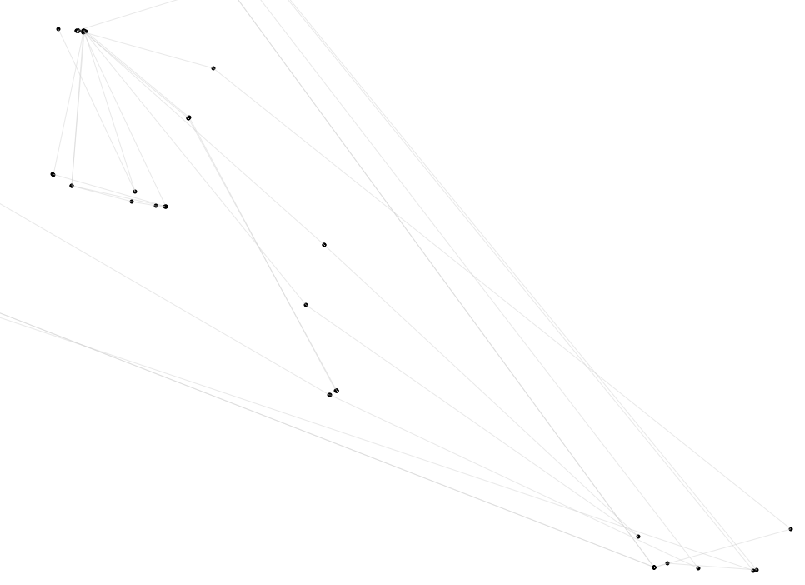Geographies of Movement
Over the last few months I’ve conducted a mobile diary study with rangers at the study site, Wilson’s Promontory National Park. Six participants were asked to record a number of entries as they went about their daily activities: a) Things they wanted to show other people, b) interesting observations for themselves, and c) recollections of a past experience, amongst others. Analysing the qualitative contents of these entries has revealed much about the connections between Parks Victoria staff, the park itself, and their tools and technology. At the same time, I’ve been doing some programmatic/quantitative analysis of the entries – mainly, the combination of timestamps and the attached location data.
I’d like to give a quick overview of some of the early findings of the study. Before that though, it’s worth talking a little about movement, and how this has come to be understood as a key source of environmental understanding.
Movement is knowing
Movement and mobility are becoming key concerns in the areas of sociology, human geography and ubiquitous computing. The sociologist John Urry (2006) suggests that mobility – the flow of information, people, and goods – rather than fixed societies will be a key concern for sociologists this century. Similarly, in human geography the notion of unblocked space (Thrift, 2003) is one concerned not with fixed points, but with movement and flows through these spaces. Thrift argues that space should be viewed not as a boundary around these flows, but as the flows themselves. In this sense, movement through a space is the definition of it.
The synthesis of these and other theories are starting to inform elements of ubiquitous computing research. Distinctions between “space” and “place” have been used by CSCW researchers as a means of separating a “socially constructed” place, and the objective space for some time. By focusing on flow and mobility, researchers now to also view space as a social construct. As such, it’s possible to argue that our environmental understanding is tied up in our constructed notions of space. Bidwell et al. (2011) demonstrate this by looking at rural knowledge traditions in Africa which are often explained as spatial relationships. Brewer & Dourish (2008) similarly present cultural accounts of space, and highlight that much of our technology relies on assumptions about how we interact with our environment.
Both of these papers discuss spatial relationships in the context of knowledge, and highlight ways in which technology may be better designed to more closely match different conceptions of space.
The acts of Rangers
Ranger’s work is to manage the park; they do this through interacting with it, and it is through these interactions that they produce knowledge. The diagram above shows where diary entries were made (with a dot), but also the path they took between entries. Most entries were reports of things that happened between the last entry and the current one. This means that much of what rangers thought to be important happened on the lines – that is, in their movement between places. Keeping with the notions of flow and mobility mentioned above, the lines can be viewed as the space of the park, as enacted by the rangers. These abstract dots and lines, for them, are one way of representing the park as they act in it.
This picture also obviously emerges a sense of “hubs” – areas where rangers go back to, and move between commonly. I’m guessing most people familiar with the park will be able to pick out where these areas actually are based on this diagram. It’s these places where knowledge “from the field” is primarily shared, interpreted and enacted upon.
The lines going off the screen also indicate that the management of the park occurs not just in the park – the “geography of management” includes administration hubs in the city and surround areas of Gippsland. Whilst this image is centred on the (invisible) geographic area of the actual park, a significant portion of entries occur “off site”. The park is just one place in the network of movements and actions carried out by rangers.
There’s a lot more to say around this study. As I start writing the thesis chapter I have planned, I’ll keep posting refinements. In the meantime, enjoy the reading below!
References
Bidwell, N. J., Winschiers-Theophilus, H., Koch Kapuire, G., & Rehm, M. (2011). Pushing personhood into place: Situating media in rural knowledge in Africa. International Journal of Human-Computer Studies, 69(10), 618–631.
BREWER, J., & Dourish, P. (2008). Storied spaces: Cultural accounts of mobility, technology, and environmental knowing. International Journal of Human-Computer Studies, 66(12).
Thrift, N. (2003). Key concepts in geography.
Urry, J. (2006). The new mobilities paradigm. Environment and Planning A.
Search
Geoplaced
This is a notebook exploring the gaps between geography, sociology, technology, science fiction and things between.
I used to write about my PhD here, which I finished in July 2013. You can download a PDF or order a print-on-demand copy of my PhD thesis.
Themes
- art (1)
- Augmented Reality (2)
- Brain Dump (17)
- Conducting a PhD (13)
- Context (6)
- essay-a-fortnight (2)
- fiction (1)
- Government (1)
- How to: Get a PhD (5)
- inspiration (4)
- Knowledge (15)
- Location (19)
- Methods (6)
- Mobile (2)
- Parks Vic (17)
- Place/Space (5)
- Research Questions (11)
- Technology (3)
- travel (1)
- ubicomp (7)
- Uncategorized (11)
- Visualisation (10)

